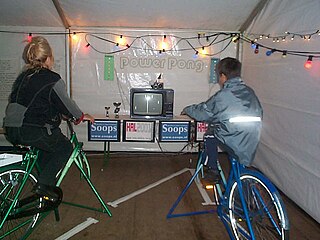
The Atari 2600 is a home video game console developed and produced by Atari, Inc. Released in September 1977 as the Atari Video Computer System, it popularized microprocessor-based hardware and games stored on swappable ROM cartridges, a format first used with the Fairchild Channel F in 1976. The VCS was bundled with two joystick controllers, a conjoined pair of paddle controllers, and a game cartridge—initially Combat and later Pac-Man. Sears sold the system as the Tele-Games Video Arcade. Atari rebranded the VCS as the Atari 2600 in November 1982 alongside the release of the Atari 5200.

The Atari 5200 SuperSystem or simply Atari 5200 is a home video game console introduced in 1982 by Atari, Inc. as a higher-end complement for the popular Atari Video Computer System. The VCS was renamed to the Atari 2600 at the time of the 5200's launch. Created to compete with Mattel's Intellivision, the 5200 wound up a direct competitor of ColecoVision shortly after its release. While the Coleco system shipped with the first home version of Nintendo's Donkey Kong, the 5200 included the 1978 arcade game Super Breakout which had already appeared on the Atari 8-bit family and Atari VCS in 1979 and 1981 respectively.
Guru Meditation started as an error notice displayed by the Amiga computer when it crashes. It is now also used by Varnish, a software component used by many content-heavy websites. This has led to many internet users seeing a "Guru Meditation" message when these websites suffer crashes or other issues. It is analogous to the "Blue Screen of Death" in Microsoft Windows operating systems, or a kernel panic in Unix.

A game controller, gaming controller, or simply controller, is an input device or input/output device used with video games or entertainment systems to provide input to a video game. Input devices that have been classified as game controllers include keyboards, mice, gamepads, and joysticks, as well as special purpose devices, such as steering wheels for driving games and light guns for shooting games. Controllers designs have evolved to include directional pads, multiple buttons, analog sticks, joysticks, motion detection, touch screens and a plethora of other features.

Pitfall! is a video game developed by David Crane for the Atari 2600 and released in 1982 by Activision. The player controls Pitfall Harry, who has a time limit of 20 minutes to seek treasure in a jungle. The game world is populated by enemies and hazards that variously cause the player to lose lives or points.

Combat is a 1977 video game by Atari, Inc. for the Atari Video Computer System. In the game, two players controlling either a tank, a biplane, or a jet fire missiles at each other for two minutes and sixteen seconds. Points are scored by hitting the opponent, and the player with the most points when the time runs out wins. Variations on the gameplay introduce elements such as invisible vehicles, missiles that ricochet off of walls, and different playing fields.

Fitness game, exergame, and gamercise are terms used for video games that are also a form of exercise. Fitness games rely on technology that tracks body movement or reaction. The genre has been used to challenge the stereotype of gaming as a sedentary activity, and promoting an active lifestyle among gamers. Fitness games are seen as evolving from technology aimed at making exercise more fun.

Amiga Corporation was a United States computer company formed in the early 1980s as Hi-Toro. It is most famous for having developed the Amiga computer, code named Lorraine.

In the history of video games, the second-generation era refers to computer and video games, video game consoles, and handheld video game consoles available from 1976 to 1992. Notable platforms of the second generation include the Fairchild Channel F, Atari 2600, Intellivision, Odyssey 2, and ColecoVision. The generation began in November 1976 with the release of the Fairchild Channel F. This was followed by the Atari 2600 in 1977, Magnavox Odyssey² in 1978, Intellivision in 1980 and then the Emerson Arcadia 2001, ColecoVision, Atari 5200, and Vectrex, all in 1982. By the end of the era, there were over 15 different consoles. It coincided with, and was partly fuelled by, the golden age of arcade video games. This peak era of popularity and innovation for the medium resulted in many games for second generation home consoles being ports of arcade games. Space Invaders, the first "killer app" arcade game to be ported, was released in 1980 for the Atari 2600, though earlier Atari-published arcade games were ported to the 2600 previously. Coleco packaged Nintendo's Donkey Kong with the ColecoVision when it was released in August 1982.

Star Ship is a first-person space combat simulator video game programmed by Bob Whitehead and published by Atari, Inc. for its Video Computer System. The game was one of the nine launch titles offered when the Atari VCS was released on September 11, 1977. Based on the Atari arcade game Starship 1, it was the first space-related game developed for the Atari VCS. The re-branded Sears TeleGames version is titled Outer Space.

Basketball is an Atari 2600 video game programmed by Alan Miller and published by Atari, Inc. in 1978. The cartridge presents a simple game of one-on-one basketball playable by one or two players, one of the few early Atari 2600 titles to have a single-player mode with an AI-controlled opponent. Miller wrote a version of Basketball for the Atari 8-bit family with improved graphics, published in 1979. That same year, an arcade version similar to the computer port was released by Atari but in black and white.

Pac-Man is a 1982 maze video game developed and published by Atari, Inc. under official license by Namco, and an adaptation of the 1980 hit arcade game of the same name. The player controls the title character, who attempts to consume all of the wafers in a maze while avoiding four ghosts that pursue him. Eating flashing wafers at the corners of the screen causes the ghosts to temporarily turn blue and flee, allowing Pac-Man to eat them for bonus points. Once eaten, a ghost is reduced to a pair of eyes, which return to the center of the maze to be restored.

Stella is an emulator of the Atari 2600 game console, and takes its name from the console's codename. It is open-source, and runs on most major modern platforms including Windows, Mac OS X, and Linux. Stella was originally written in 1996 by Bradford W. Mott, and is now maintained by Stephen Anthony.

The Atari 2600 hardware was based on the MOS Technology 6507 chip, offering a maximum resolution of 160 x 192 pixels (NTSC), 128 colors, 128 bytes of RAM with 4 KB on cartridges. The design experienced many makeovers and revisions during its 14-year production history, from the original "heavy sixer" to the Atari 2600 Jr. at the end. The system also has many controllers and third-party peripherals.

Ian Bogost is an American academic and video game designer, most known for the game Cow Clicker. He holds a joint professorship at Washington University as director and professor of the Film and Media Studies program in Arts & Sciences and the McKelvey School of Engineering. He previously held a joint professorship in the School of Literature, Media, and Communication and in Interactive Computing in the College of Computing at the Georgia Institute of Technology, where he was the Ivan Allen College of Liberal Arts Distinguished Chair in Media Studies.

Skiing is a video game cartridge for the Atari 2600. It was authored by Bob Whitehead and released by Activision in 1980. It's one of the first video games developed by Activision.

The first hobbyist-developed game for the Atari 2600 video game console was written in 1995, and more than 100 have been released since then. The majority of games are unlicensed clones of games for other platforms, and there are some also original games and ROM hacks. With only 128 bytes of RAM, no frame buffer, and the code and visuals closely intertwined, the 2600 is a difficult machine to program. and many games were written for the technical challenge. Emulators, programming tools, and documentation are available.

M Network was a video game division of Mattel that, in the 1980s, produced games in cartridge format for the Atari 2600 video game system.

The Atari joystick port is a computer port used to connect various gaming controllers to game console and home computer systems in the 1970s to the 1990s. It was originally introduced on the Atari 2600 in 1977 and then used on the Atari 400 and 800 in 1979. It went cross-platform with the VIC-20 in 1981, and was then used on many following machines from both companies, as well as a growing list of 3rd party machines like the MSX platform and various Sega consoles.
















